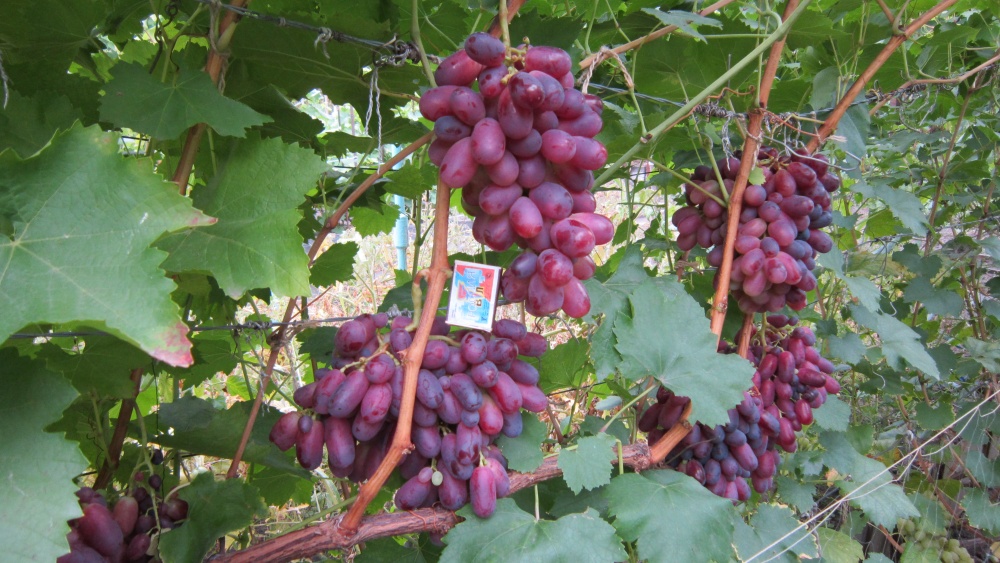
Gardeners prefer breeding varieties tested over the years. These include Rizamat. Bred in a selective way, the culture is notable for its fruitfulness and quality of berries. Even the whimsicality of the plant does not reduce the enthusiasm in its cultivation.
Content
Grade Features
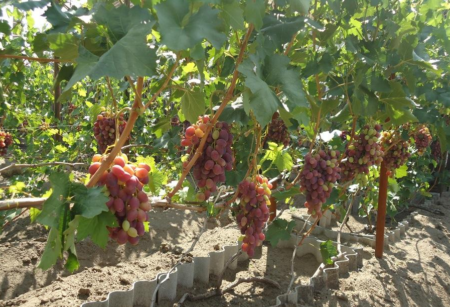
Grape named after the famous breeder Rizamat Musamuhmedov. Rizamat was bred by crossing the varieties Katta-Kurgan and Parquet. He loves the abundance of the sun and high temperatures. Originally grown in Uzbekistan and Turkmenistan. But over time, it became widespread in the southern regions of Ukraine, Russia, and Kazakhstan.
Based on the variety, hybrids were bred: Rizamat stable, Rizamat excellent, Rizamat peerless. They are particularly resistant to adverse weather conditions, have strong immunity. But the quality of the fruit can not equal the desired variety.
Variety - medium-early; berries ripen in early August - mid-September (depending on the climate). By appointment - universal. From berries you can cook stewed fruit, jam, eat fresh. When drying, it turns out great large dark raisins.
The stems have a tree structure, bright brown, large. The leaves are green, medium in size, smooth, without a lower edge, five-armed, but without pronounced incisions. The clusters are large, conical. With good yields, they can weigh up to 3 kilograms.
Bisexual flowers that do not require additional pollination. Planting other plants to the bushes for full pollination is not necessary. Grape gives, with proper care, good lasting yields.
The berries are large, oblong. One barrel of each berry is brighter. The fruit itself is intense pink. The skin is thin, with a light wax coating. The taste is sweet. In ripe berries, about 25% sucrose. Their weight can reach 6 - 14 grams.
Pros and Cons of Grapes
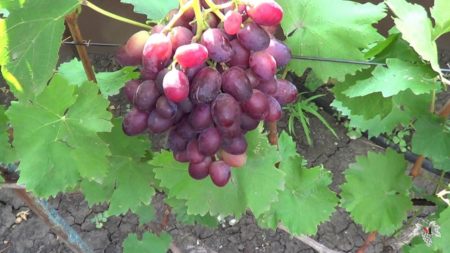
Despite the capriciousness of grapes, many gardeners love to grow it. The plant has many attractive advantages:
- gives large yields of berries (up to 25 tons per hectare);
- has universal use of berries;
- has an attractive presentation;
- well transported;
- flowers do not require additional pollination.
Meanwhile, the variety has many disadvantages:
- has low frost resistance;
- does not like high humidity (the fruits of this begin to crack);
- requires constant painstaking care;
- susceptible to fungal diseases.
Grape planting
It is advisable to propagate grape seedlings. For this, parts of the trunk are selected and placed in water until the first roots appear. Another way: put the branches in moist soil. Some gardeners propagate Rizamat by layering. With this method, it is not recommended to quickly disconnect the twig from the mother trunk. Otherwise, the plant will be frail and will require longer care.
Before planting seedlings, pits should be prepared. An important rule in this case is the occurrence of the bottom two meters above groundwater. Pits are dug with a depth of about 80 cm.At the bottom lay gravel or broken brick. About eight centimeters thick.
Next, you should fill the pit with soil at 10 cm. Then fertilizer is applied. Organic (compost, manure) is desirable. Some gardeners add phosphate-potassium fertilizers. From above they are sprinkled with loose soil 10 cm thick. Then the pits are left to settle for about 14 days.
Landing is recommended in the spring. In the autumn period, there is a danger that frost-resistant plants will die during the first frosts. Or will be frail and easily susceptible to disease.
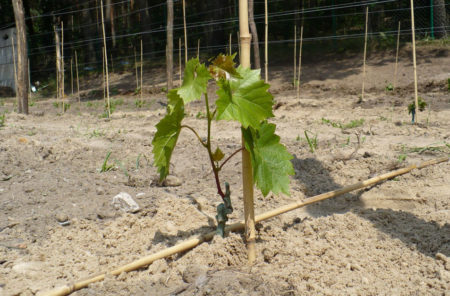
When planting seedlings, some nuances should be taken into account. It is not recommended to plant them mixed with other grape varieties. Rizamat loves space and does not get along well with neighbors. If the intention to form a common vineyard is still present, the distance between the plants should not be less than 3 meters.
The distance from the fence and from the walls of the house should be at least one meter. The distance between the seedlings themselves when planting is observed from a meter to a meter and a half. The variety Rizamat is photophilous and thermophilic. Therefore, it must be planted on the south side of the site.
Prepared seedlings are placed in pits, taking into account all the nuances. Two buckets of water are poured there, after which they are covered with loose earth. From above it is desirable to mulch the soil. Shoots are tied to an upright support to give them a direction of growth.
Care Features
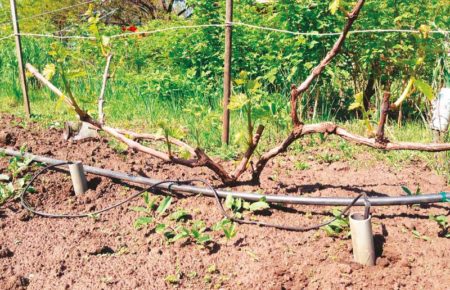
Rizamat is very moody grape sort. It requires particularly careful care. But it rewards handsomely, giving rich harvests of berries.
Watering and fertilizing
The vineyard loves moist soil. It should be watered abundantly 3-4 times until the ovary is received and the crop is ripe. During these periods, the frequency of watering is reduced to 2 times per month. If the soil is too waterlogged when the berries are ripe, they may begin to crack. If it is not enough to water, the berries begin to grow smaller.
It’s just not recommended to pour water under the bushes, since it spreads without reaching the roots. It is better to make small holes in the root system and fill it with moisture. It is good to add organic and inorganic fertilizers to it. Feeding with compost, wood ash, together with potassium, nitrogen and phosphorus gives the desired results.
After watering, it is necessary to mulch the soil every time. Dry moss, grass, twigs, sawdust will do. The mulch layer must be at least 3 centimeters.
Pruning bushes
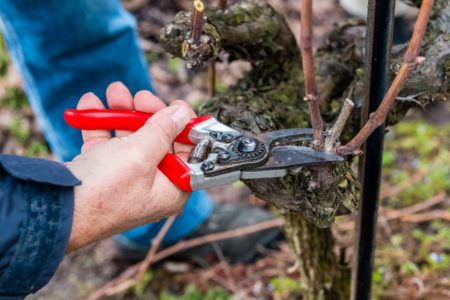
Vineyard requires annual fall trimming. When cutting long shoots, trunks should be left for 14 eyes, and on each bush - no more than 60 eyes. If you leave more, it may affect the level of the crop.
If you leave fewer eyes, it is also unfavorable for the crop. Stepsons who do not give clusters will grow. When clustering, thin out the leaves. Above each bunch it is recommended to leave no more than 15 leaves. So, the berries will receive more light and will be larger.
Rizamat does not tolerate severe frosts. At temperatures above 18 degrees, it perishes. Therefore, it is recommended to insulate the shoots of the variety for the winter. They are bent, tied to the bottom of the stems. Plants are wrapped in burlap, then in a plastic film, in which small holes are made so as not to froth. Then back to the burlap.
Salvation from Diseases and Pests
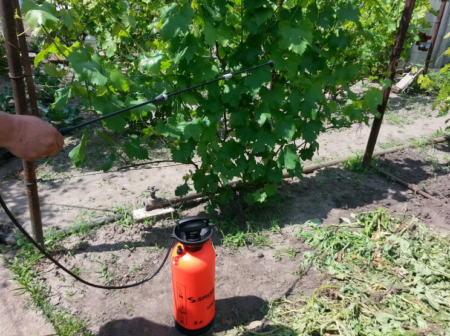
A significant minus of the variety is a slight susceptibility to fungal diseases (mildew and oidium). Therefore, you should constantly monitor the condition of plants. Thick foliage must be thinned out; constantly inspect leaves and shoots.
To combat fungal diseases, a special decoction of lime and sulfur is suitable. They should process leaflets to prevent the appearance of mildew or oidium. The solution is safe for humans and animals, environmentally friendly.
We also apply the folk method of processing plants - irrigating bushes with wine or apple vinegar. Such funds are completely safe, but show excellent results in the fight against fungal diseases.
Grape berries are very attracted to birds and wasps. If you do not take measures, they can significantly reduce the productivity of the bushes. Bushes should be covered with a special net. Another way that protects clusters from pests is by hanging gauze wraps on each bunch.
Harvesting and storage
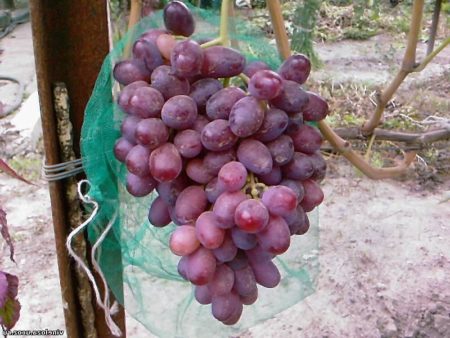
Grape berries ripen in late August - early September. Maturation occurs gradually, starting from the upper branches to the lower ones at the base of the bushes. Fresh clusters are recommended to immediately cut.
Store them in a cool cellar or refrigerator. The storage time is about 2 weeks. The variety looks attractive and lends itself well to transportation. Therefore, it is advantageous to transport it to retail outlets for sale.
Some gardeners are grown Rizamat specially for making raisins. The product is of high taste. It looks great and has trade value. To use grapes for raisins, ripe clusters are not harvested immediately when they are ripened, but are allowed to hang on the bushes for about 2 weeks.
Reviews of amateur gardeners
Andrey, 34 years old
I’ve been divorcing Rizamat for a long time. But recently I began to think about replacing the variety. He is very gentle. I live in rainy areas, and I am unlucky with the harvest all the time. If you manage to remove the clusters before the rains - this is a great joy. But more often I do not have time. And after the rain, most of the berries burst and become rotten. It is better to grow something more resistant to moisture.
Alexander, 62 years old
I wanted to try to grow grapes on my site. The choice fell on Rizamat. Began to bear fruit only last year. As it turned out, the cause of the delay was too short trimming. Then I tried a long trim. And it all worked out. The grapes in the variety are large, the berries are crisp and tasty. The variety was enjoyed by the whole family.
Alexey, 47 years old
Rizamat has large berries, they are round-oblong and oblong. At least in my bush they are of different shapes. Grapes ripen unevenly, starting from the top and then closer to the middle of the bushes. Bunches ripen closer to the beginning of September. I grow for sale. Therefore, presentation is important. And the variety is excellent.
Variety Rizamat seems to many attractive. Early ripe grapes ripen at the beginning of the fall season. Ripe berries have an excellent sweet taste. Grape can be consumed not only fresh, but also boiled, pickled, dried. For these qualities, Rizamat is grown in various climatic zones. With proper care, it is possible to achieve large yields.




 Non-covering winter-hardy grape varieties for Moscow region
Non-covering winter-hardy grape varieties for Moscow region How to keep the vine in winter
How to keep the vine in winter When can I transfer grapes to another place in the fall
When can I transfer grapes to another place in the fall How to cover and prepare grapes for the winter in the suburbs
How to cover and prepare grapes for the winter in the suburbs